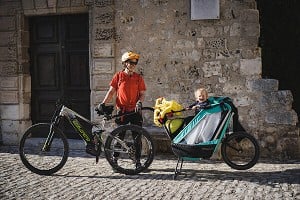
Hugo Da Roit introduces an unexpected climbing paradise in France's far north...
Have you ever heard of Normandy? You most likely have! But have you ever heard about climbing in Normandy? I bet you haven't!
Normandy is a region of France located in the northwest; it's mostly flat and filled with crops and cows. The region is known for its rich history, including the Vikings, William the Conqueror and more recently for the Normandy landings during WW2. You may also know the region for its cheese and its alcohol from apples and pears.
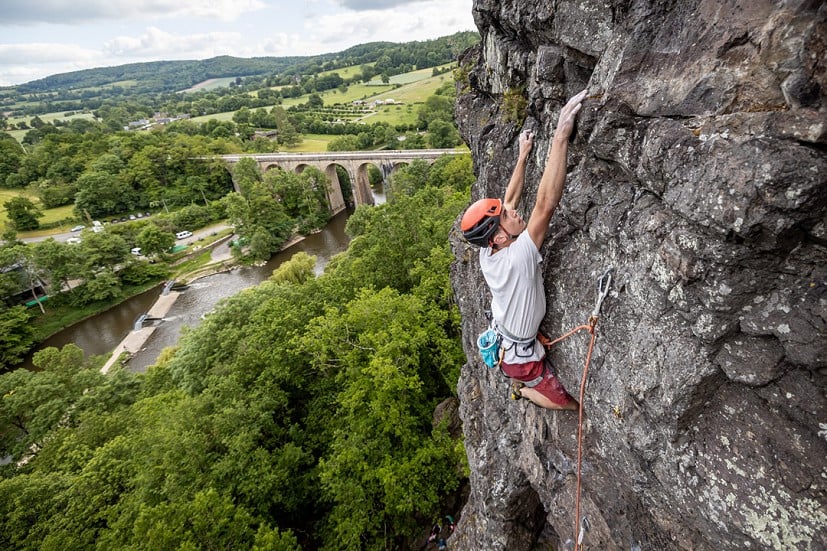
Normandy is bordered by more than 600km of coast. The west of Normandy is part of the Armorican massif and offers numerous bocage, rugged and verdant relief bringing most of the climbing opportunities here in Normandy. The east part of Normandy has an even flatter relief but comes with a lot of cliffs which border the laces of the Seine (the main river, going from Le Havre to Paris and beyond). The climbing is mostly inland, cliffs close to the sea are numerous but some are forbidden and a lot of them have really poor rock.
The region does not boast any major climbing spots like Fontainebleau, Ceüse, Verdon, Chamonix, the Calanques, … But by combining all of the climbing sites we have, it is worth considering a climbing trip to Normandy, and you can pair it up with sightseeing! You may even travel to our dear neighbour, Brittany. So, if you ever come near Normandy, it is very much worth bringing your climbing shoes to climb here. The climbing is mainly athletic, short and bouldery. You can also find some longer routes (up to 35 metres) and a lot of the climbing is easy, mainly in the 5s and 6s. It's also a perfect place for families.
Climbing in Normandy is not new. The needle, "l'aiguille", of Mortain was climbed in the '40s and the first routes on the cliffs along the Seine in the '50s! The history of climbing in Normandy is similar to that of France; free climbing arrived in Mortain thanks to Didier Laisné, Jean-Pierre Bouvier alias "la mouche" and other stout guys at the beginning of the '70s, and this, even before Jean-Claude Droyer (one of the forerunners of free climbing in France) came here in 1975. The war of the pitons did take place, over the same period, and it was also led by the Mortain group in the western part of Normandy, formerly called Basse-Normandie.
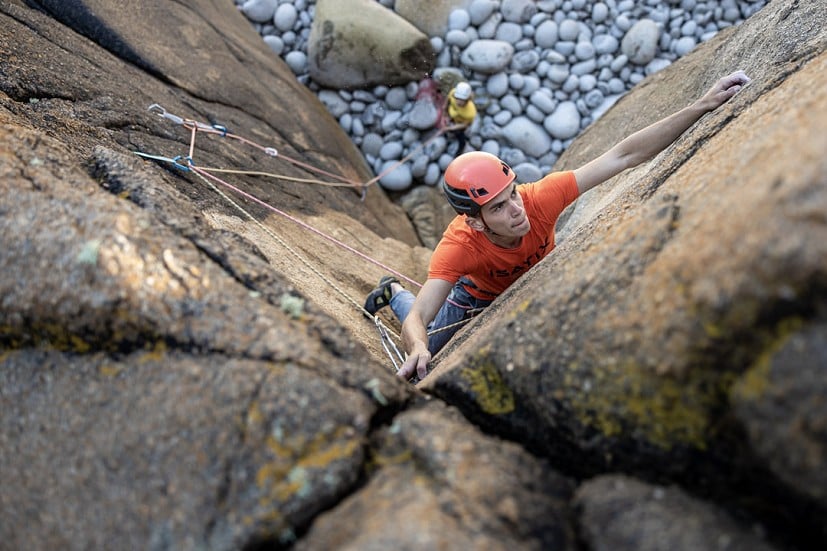
Letters, each more ferocious than the other, were sent between the different protagonists, resulting in the democratisation of free climbing without any broken jaws. On the other side of Normandy, the 'yellowing' (it was common at this period in France to paint in yellow the pitons you didn't use to let people know, and even remove them) was also going well, thanks to Christophe Profit, Jean-Michel Gossellin and Roland Trivellini. Normandy also participated in the rise of sport climbing levels, with routes like Papa Litz (7a) or Linceuil noir (7b) on the cliffs along the Seine, which were among the first routes of this level in France.
Nowadays, almost all the climbing sites are well bolted by following the federal recommendation. You will only find glue-in bolts. Some sites used to have some space between the bolts, but thanks to the work of dozens of volunteers, federations and climbing professionals you can now come to Normandy without any fear! Of course, you are still in a natural environment, so be careful when climbing and belaying and come with some common sense.
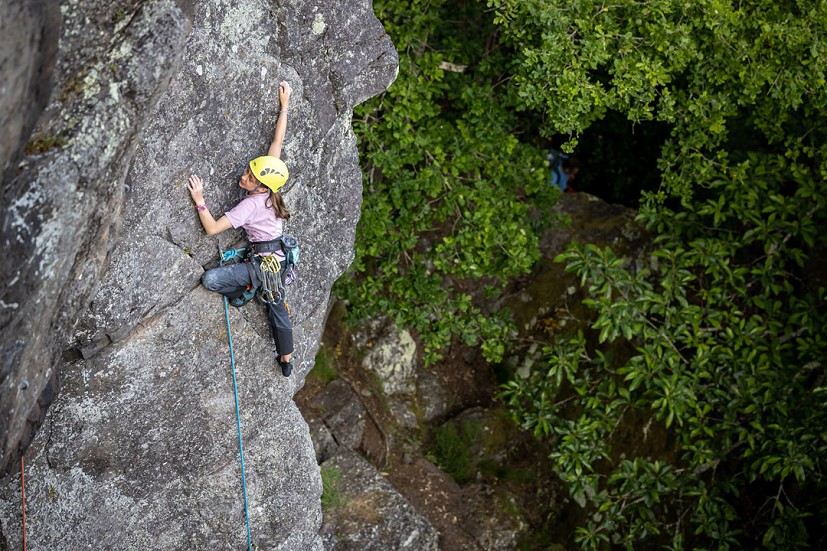
You will find about thirty cliffs, of all sizes (from a few routes to several hundreds). There are a few bouldering sites. Many of the cliffs have easy routes, from grades 3 to 6. But there are many cliffs where climbers can express themselves up to 8b+ in routes and 7C in bouldering. And there are still a few projects, some not bolted, and several cliffs by the sea to discover and develop!
Come with me for a tour of the best climbing spots in Normandy!
Hugo Da Roit
Cliffs along the Seine
The first climbs on the cliffs along the Seine seem to date from the 1940s, i.e. from the beginnings of rock climbing as a discipline in and of itself. The first pitons were installed in the '50s and '60s and bolts began to appear in the early '80s. Today, after a vast project in 2009 with the help of the Eure department and the beginning of an annual maintenance program, the bolts are reliable and comply with federal recommendations. The glued bolts are 300mm deep, so you can fall and flfly without any problem!
These cliffs are very frequented by the local climbers, but also by the climbers of the Paris region which is one hour away by car.
The climbing is atypical, athletic on flinty limestone. This can be confusing at the beginning and no trace of chalk will guide you on this white, immaculate, rock. It's always a real onsight climbing test.
Nearly 500 routes exist, so everyone can find what they are looking for. Easy sectors for children are regularly overcrowded as well as the overhangs for the octogradists.
The cliffs are located on slopes classified "Natura 2000", and for many years, a partnership has been set up between climbers and the "Conservatoire des Espaces Naturels", an association that protects the environment, to contribute to the preservation of the calcicole grasslands and endemic species (the famous "Violette de Rouen"). The climbing federation committee of the Eure department is a major actor in the monitoring and preservation of the Peregrine Falcon, alongside the "Ligue de Protection des Oiseaux", another environmental association. Nesting boxes are dug, faeces are collected, and awareness-raising operations are carried out for climbers.
The rock is very specific on the cliffs of the Seine: white and powdery limestone like chalk with flint strata. There is something for everyone: vertical, dihedrals, big overhangs and overhangs, easy, a little harder... and even harder! And all this is spread over 8 sectors, each one more interesting than the other. You will find bouldery routes and longer technical routes on porous rock with holes and flints. The heights of the routes go from 10m to almost 25m. The sites are exposed east, south and west and therefore receive sun during the day. It is not uncommon to see climbers in T-shirts or shirtless as early as February. The bolts, clean and neat, have been planned for the pleasure of all, whatever the level. All the routes have chained anchors, except for the sectors classified as adventurous terrain ("Terrain d'Aventure") (Conelles and the M). Given the rock type, rock falls are to be anticipated and helmets are highly recommended.
Note: there are sublime viewpoints on each sector, with a fantastic panorama of the banks of the Seine.
Sectors
From Andelys downstream, always on the right side:
Le Val Saint Martin : 150 routes from 4 to 6c, the paradise for intermediate climbers.
Le Thuit : 25 routes from 6c to 8b for the strong climbers
La Spéléologue and la Bisexto : For the climbers who like two finger pockets and monos, mostly in the 7th degree, this is a classic sector
La Micro Falaise : not very high but the climbing is nice
Right side, at the opposite of the bank of Poses :
Connelles and the M : the two historical sectors to revise the classics in TD+, 6a/b as we say now.
La seconde jeunesse : The new one, recently rebolted after 40 years of sleep. About twenty routes, mainly in the 5/6 grades.
Best of:
"Requin d'Acier" at Val Saint Martin 6a
"Top Gun" at Le Thuit 8a
" Asile" at La Spéléologue 7a
"Papa Litz" at Bisexto 7a
"Princesse Nolwenn" at the Microfalaise 6b
La Daubée" at Connelles 6a+
"Furax" at L'M 6b
"Vipère" at Seconde Jeunesse 6b
Kids are welcome
There is everything you need on the cliffs along the Seine to come and climb with children. Helmets strongly recommended.
Logistics
The cliffs are located on the right side downstream from the city "Les Andelys" and on the right side at the opposite of the bank of Poses. Because of the mainly southern orientation and the rock which dries quickly, you can climb all year long.
The guidebook
A new edition was published in 2019. Pricing is 26 €. For orders and more information, visit here and you can order directly at: topo@ct27.ffme.fr
It is also available in the tourist office of Andelys.
Accommodation
The Seine valley, with the Gaillard castle, is a very popular tourist spot. A multitude of accommodations, from camping to bed and breakfast are proposed. More information and reservations here.
Other activities
Here, outdoor sports are really common and well-developed. Kayaking, mountain bike, paragliding, caving, windsurfing etc... The "Seine à vélo" cycle route from Paris to Le Havre passes near the climbing sites. The leisure centre of Léry-Poses organises services for all or some of these activities.
Rouen and Paris are close if you want to do some sightseeing.
FFME committee of Eure
Clécy, a little mountain air in Normandy
Clécy, unlike the cliffs along the Seine, is not a temple of difficulty. On the contrary, the vast majority of the routes do not exceed the 7th grade. However, for decades, this cliff has been a popular destination for many climbers, especially during long spring weekends. So it is not the difficulty that attracts crowds to one of the most famous cliffs in the West of France, but something else.
You are entering "Suisse Normande" (Norman Switzerland), an atypical area of Normandy, far from the clichés evoking a flat countryside. The Orne, the river that ends its course in the Channel, has carved the rock to reveal outcrops. Multiple valleys decorate a beautiful landscape. At the foot of this river, in a bucolic setting, the crag is a perfect climbing spot. The crag is all the more preserved as it is located in a sensitive natural space managed by the Calvados departmental council. This is one of the reasons why climbing on the Rochers des Parcs is limited to the westernmost sectors of this immense rocky bar. Even if the oldest climbers were able to explore the rest of the cliff until the '90s, it is now reserved for the free development of nature, especially of particularly rare lichens.

Clécy consists of more than 130 routes with - rare in Normandy - routes of several pitches. Of course, you don't go for several hundred metres of vertical flight. However, the atmosphere is different from a more traditional site. Many people appreciate coming for their first experience of belaying in a multipitch and many come back after having got a taste for it.
Clécy is a site without many difficult routes, but it offers many that are accessible to the average climber. However, it must be said that many people find the routes a little undergraded. These grades are often here thanks to a long and rich history which started more than 70 years ago. It is true that if the routes may seem easy to those who repeat them tirelessly, they offer difficult route reading to those who are used to more conventional routes... especially for people coming from climbing gyms.
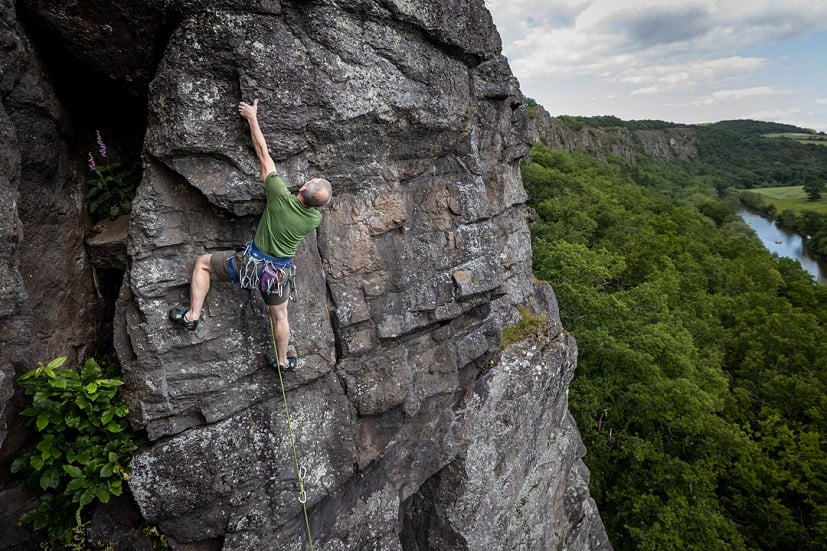
But be careful, a route of low difficulty does not mean it's easy or without issues. The structure of the cliff consists of ledges, edges and other promontories in places, making falls complex.
History
Clécy is a climbing site with a particularly rich history. Its development started before the '50s. It was the "high" Normans (those who lived in the eastern part of Normandy) who were really the first to clean and climb the cliffs, followed by the people from Caen. However, from their first "ascents" (people came here to prepare for the mountains), they discovered the remains of pitons which showed that people came here before them!
Over the years, the cliff has experienced all the evolutions of climbing, especially during the sport climbing revolution.
Sectors
Clécy offers two distinct sectors. The most obvious one, the Rochers des Parcs, is the one everyone knows. Facing the outdoor centre, La Base Lionel Terray, the easy sectors have been particularly developed. But the price of success is that, on busy days, these sectors are saturated. Other sectors are also very popular, such as La Reposante, for its magnificent routes such as the Archiduchesse or the Dalle des Parisiens.
The choice here is varied both in difficulty and in the climbing styles offered.
The least known is Le pain de sucre. It is however the one where climbing really started here in the '50s. Abandoned for a long time, it is now enjoying a second youth thanks to the work of François Leonardon, Hugo Da Roit and Sébastien Gras. The access is more complicated and it will not make this sector a frequented area. But for climbers well experienced in the sixth degree, stunning routes await them in a slightly wilder atmosphere.
Logistics
Clécy is located 30 minutes south of Caen. The two sectors presented in this article are located along the Orne river. The access is described in the topo, but also on the caffmeux website.
Because of the southern orientation of the two sectors, you can climb here all year round. During certain weekends, the number of climbers is particularly high. It is important to remember that sharing and cooperation must remain the rule. This sometimes tends to be forgotten.
The guidebook
Updated in 2020, it describes all the sectors. Available at the tourist office of Clécy, at the campsite, but also "Au Vieux Campeur" online. The price is 10 Euros.
On the history of the site
A retrospective of the history of Clécy has been written by Sébastien Gras and is available on the caffmeux website already mentioned (free of charge or in print on demand).
Lodging
Clécy is an excellent place for tourism and offers a multitude of accommodation, from camping to bed and breakfasts.
Other activities
Here, outdoor sports are also really well developed. Kayaking, mountain biking, paragliding, via ferrata... La voie verte (cycling road) installed on the axis of the old train is close to the two sectors. The Lionel Terray centre and Vertig offer services for all or part of these activities.
Clécy is 30 minutes away from Caen, a beautiful city. You can visit the crag then finish by visiting the Normandy WW2 landing beaches, its museums and the war cemeteries.
Sébastien Gras
Flamanville : the definition of adventure!
Flamanville is mainly known for its nuclear power plant and unfortunately is unknown, even by the climbers in Normandy, for its superb climbing!
Located in the northern part of the Armorican massif, on the west coast of Cotentin, the magnificent granite of Flamanville is part of a massif of around 5 kilometres in diameter. This massif is mainly visible on the coast and is a huge playing field for climbers. The cliffs are invisible from the top. You need to come by car and park near the sémaphore which is now a gite and a restaurant. You'll have a splendid view and you'll notice that there are some cliffs hiding below you!
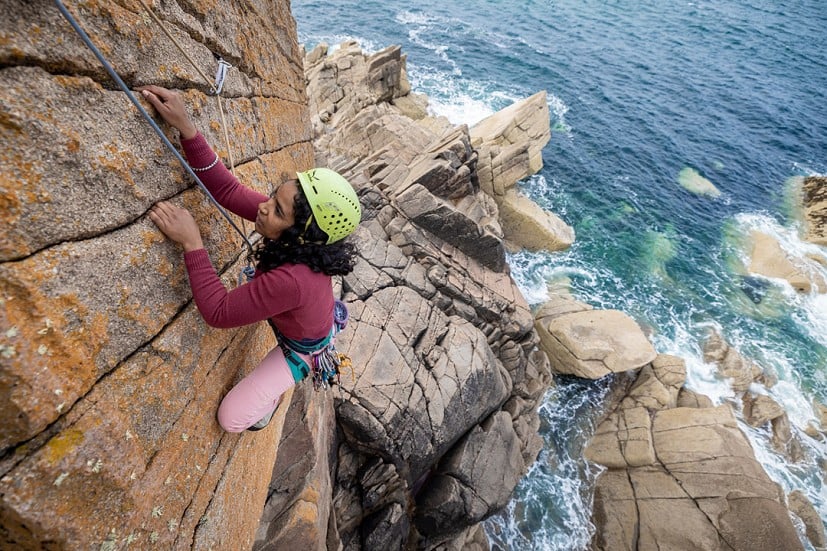
Around 3,5 kilometres of granite is accessible with pebbles of a size you can't even imagine! The coast is also filled with granite boulders and there is still a lot of potential. There are multiple sectors and some can be 35m high.
The site is classified as adventurous terrain, "terrain d'aventure", which means we only do traditional climbing here. So bring your friends, nuts and slings! You'll need them! There are some bolts here and there when some parts of a route can't be protected. There are a few anchors at the top of the sectors for abseiling. You mainly need to build the anchors by yourself: bring a lot of slings for wrapping around features. If you're not familiar with trad climbing, you can only top rope, but it will be worth it. The granite and the climbing is incredible and unique. It always reminds me of Chamonix.
Even the approach is an adventure, it will take you from 10 to 25 minutes, if you don't get lost. The trails are almost invisible at the right of the semaphore, you'll need to read the guidebook well. Bring pruning shears and don't come in shorts.
There are around 70 routes today on 7 sectors, and many more are waiting for a first ascent.
By going left to right from the parking, you can find the sector "Les terrasses" which is perfect for a traditional climbing introduction. The access is easy, which is nice, contrary to some of the other sectors. Routes in this sector are mainly in the 4 and 5 grade range. Le Rivage des Pitres, 5b/E2, Flamme éternelle 5a/E1 and L'état sauvage 5c/E1 are among the best routes on this sector. Two anchors are at the top. You can climb up to 6b+ with "Au sombre héros de la mer" which is the only bolted route in Flamanville.
Then you can go on to the sector "La crique"; abseiling is the easiest way to get here. You'll find nice routes, harder than the previous sectors. One anchor is here. The atmosphere is nice as you are in a creek of sorts; you'll feel isolated from the world.
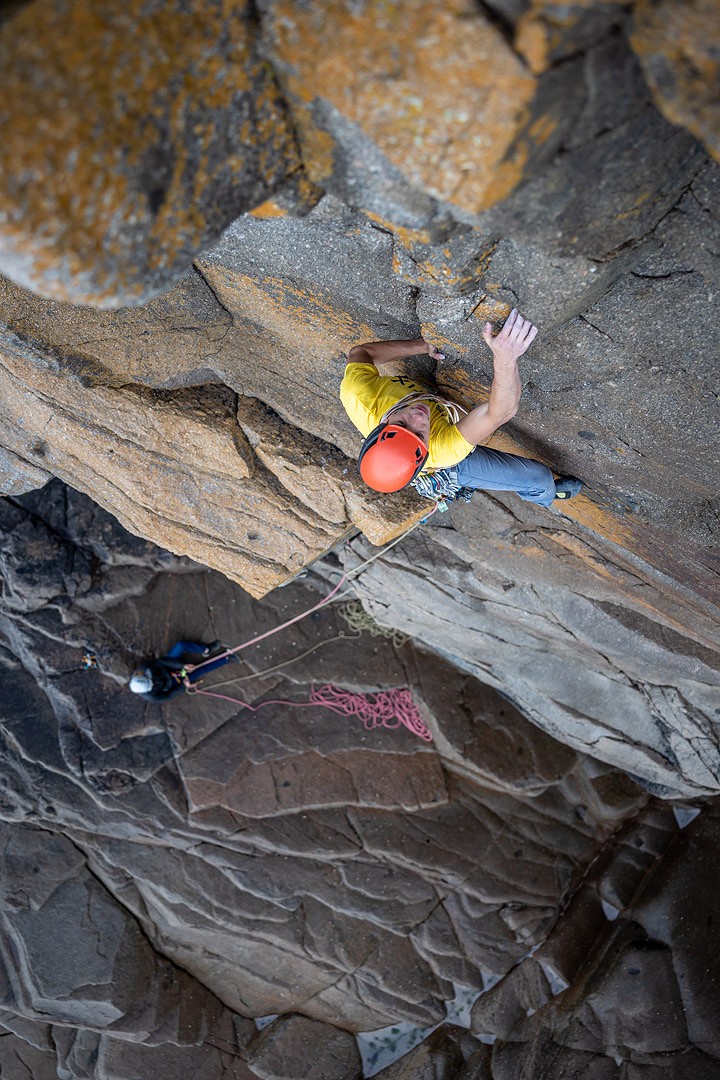
There are a few little sectors, then you'll find the sector Bivouac, which is the biggest sector here in Flamanville. It's a sector with routes up to 7b and 35m high. In the middle you'll find a beautiful slab, climbing Macadam line 6a/E2 is a must do! Then on the left side you'll find a massive overhang with no routes going through yet, it's still a project. On the right part of this overhang you'll find 10 routes or so. Around 25 routes are in the guidebook for this sector and many more are waiting for you for a first ascent. Jan, the talented photographer who followed us for the shooting, did the first ascent of a chimney on the right side of the sector and it cannot wait for its first repeat! You can bivy at the top of the sector; you'll sleep accompanied by the sound of the tide, the breeze and the gulls. The bivy is well protected from the wind.
Be careful about the tide as you can find yourself stuck. You can climb at high tide on some sectors, such as sector Bivouac on Alto Aesto 5b/E1 for instance.
Jean-Christophe Laville is the main actor here, he did the first ascent of many routes. Some climbers from the Alpine Club of Cherbourg like Jacques Lebever spent a lot of time cleaning and developing the site.
Guidebook
The Alpine Club of Cherbourg did a recent guidebook which is available online.
The topo from Jean-Christophe Laville is available on the CAFFMEUX website.
If you want to know more about the history of this site, click here.
Other activities
The area is teeming with hiking trails, notably the magnificent "sentier des douaniers" (GR223), one of the most beautiful GRs in France. The forest and the park of the castle of Flamanville have nice walking paths, but there are also trails for mountain biking. The area is also famous for surfing, windsurfing, kite-surfing, sand yachting on Siouville or Sciotot. A sailing school is in Diélette.
Saint-Clair-de-Halouze : bouldering in Normandy!
Bouldering in Normandy is possible. If several bouldering sites exist, Saint Clair is today the most successful and the most interesting. We are currently developing another site with even greater potential, but it is still a little early to talk about it.
We are here in the Armorican massif, the remainder of an ancient mountainous massif, to which the Fosse Arthour and Mortain also belong. The rock, the Armorican sandstone, offers here a great variety of holds and climbing styles: slab, overhang and vertical.
Marcel Toquet designed the first yellow circuit in the '70s, then Jacques Lebègue in a second wave notably opened two magnificent circuits (green and red rated respectively, AD and TD as in Bleau). Off-circuit boulder and sit starts were also born at the beginning of the year 2000 and offer additional difficulty often in the 7th degree or more.
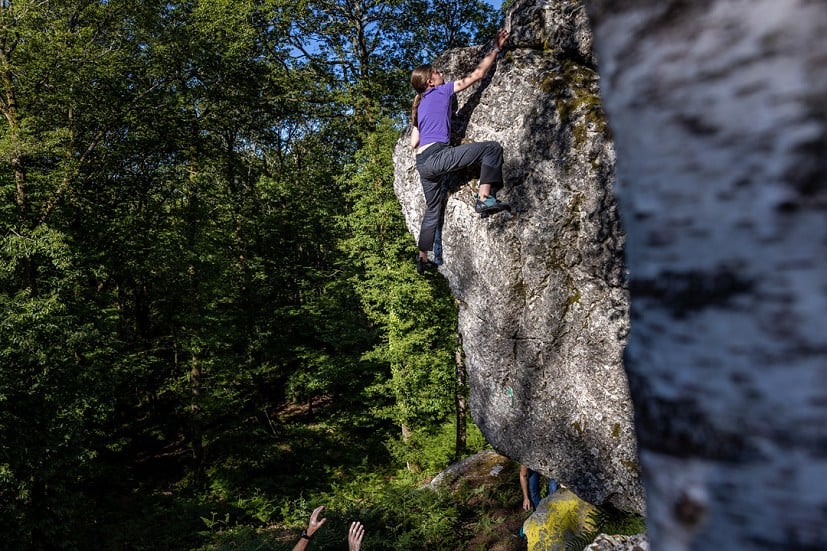
Out of the hundred or so boulders offered in the three sectors of the site, several are beautiful, like the ASB or "Accroche toi au pinceau". For the first one, it's an overhanging crack rated 5c. "Accroche toi au pinceau" is a more difficult boulder, 7A from a standing start, in a 45° panel with tiny and super sharp crimps. The sit start is much more difficult and is still waiting for a repeat after several years, or even decades I should say. Each of these boulders is a real reference for their level.
With the bouldering alone, there is enough to keep you busy for several days, but Saint Clair is not only that. Easy sport routes of the quarry sector have seen the passage of generations of children hosted by the local day care centre and the Alpine Club (CAF) of the Pays de Flers. In the Barnabé sector, the closest to the parking, the vertical face of the eponymous rock allows those who prefer sporty routes to find something to enjoy up to the 7th grade. The recent re-bolting led by Vincent Lefort and Sébastien Gras allows us to climb within current safety standards.
It was during this re-bolting that new types of routes appeared in the magnificent roof of Barnabé. The "Dry Tooling Normandy" team, led by Vincent Lefort, bolted two routes to test their ice axes.
Logistics
Saint Clair is located 15 minutes from Flers. The access is described in the topo, but also on the caffmeux site.
Because of its location in the forest, climbing there is sometimes difficult in winter after a rainy period.
For the three sectors mentioned in this article, access on foot takes 1 to 10 minutes.
The guidebook
Published in 2005, it is available at the following address:
Club Alpin du Pays de Flers
73 Rue Elie Frécourt
61100 Flers
The guidebook is also available from time to time at Isatix, a bouldering gym near Caen, or the nearest tourism office.
Other activities
Saint Clair also has a mining past whose vestiges are still visible not far from the climbing areas. Walking in the forest allows you to discover this heritage. The forest also lends itself well to mountain biking and hiking.
You can find more activities via the Flers tourist office.
Sébastien Gras
Mortain : dare to be adventurous!
To climb in Mortain, you must first go down!
From the castle square to the foot of the "Aiguille", like an archeologist going through the geological layers, you will go through our climbing history, from its last upheavals to its origins.
And the origin is the Aiguille (a needle)!
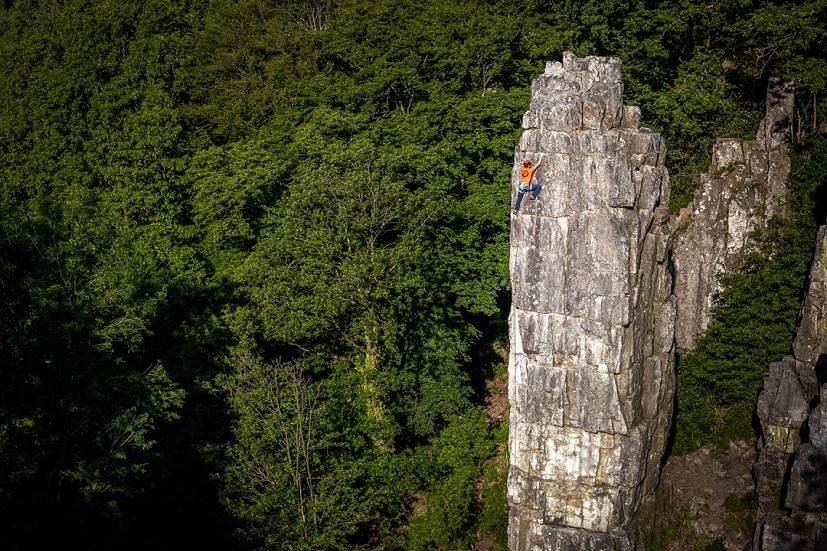
The stories about its climbing are similar to a form of mythology: that some kids baited by a few coins reached its summit is not improbable and the legend says that they jumped from the opposite plateau! On the other hand, someone could have gone up and down with a mix of audacity and talent.
The first attested proof of a "modern" ascent of the Aiguille was displayed in front of me in Doctor Collot's office in Chamonix in 1977: a photo of a young Savoyard on "Gobbi"... a crack, which could only attract Chamoniards "lost" in Mortain during WWII.
Once you have had a taste of this classic, do the Henri II, another "feat of arms", of 1971, rope around the waist, mountain boots, pitons and hammer and establishing the line "from the bottom"... its "liberation" (free ascent) in 1975 by Jean Claude Droyer was the confirmation that the new game that we (the Bouvier brothers and I) kids of Mortain had just invented - we knew all the routes by heart and we didn't pull on the gear anymore - had a certain future!
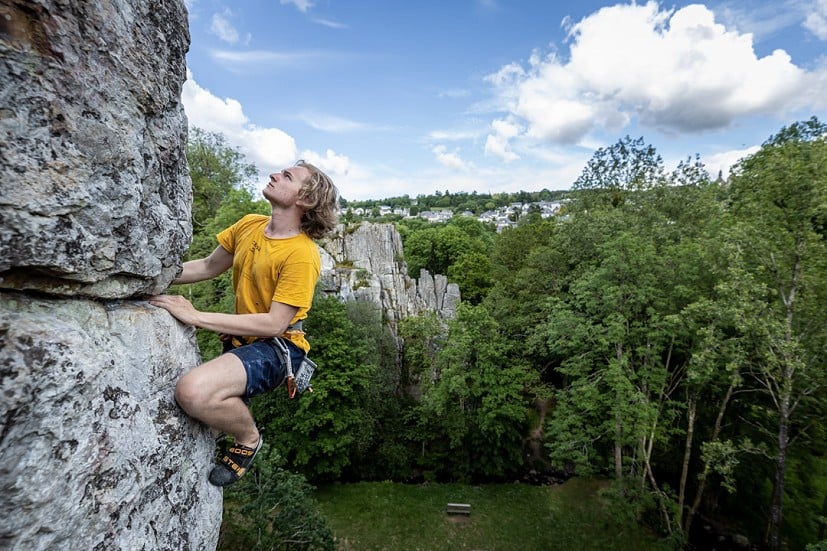
You can't leave the Aiguille without having done "L'arête des aigles" and "Pompischpratz"... and since you've warmed up, continue your discovery by following the river and climbing "Eldorado", a "jungle" atmosphere, waterfall and light filtered by the vegetation… a multi-sensory experience and the quality of the climbing is up to par! "Géronimo Lagadec, la Marque jaune" (opened by Jean Christophe Laville in 1993, ground-up, onsight with his new toys and...his talent!) and "Grand méchant roux" are to be done.
It is impossible to resist what you had ignored while descending the big smooth slab, "Baby Dalle", and why deprive yourself of it? And all these beautiful overhangs, "l'ouest le vrai", "Monotone Transfert", "Prima Vista", made of Armorican sandstone... "Divine Child" for the beauty of the movement and the name.
I fear you are pumped, but how can you leave without having tasted the excellent "A fonds la caisse!" which will conclude a beautiful day of climbing, certainly "in the old way" of climbing, but unforgettable.
Unable to be exhaustive, I haven't mentioned the numerous more accessible routes (in particular in the sector "Mysteries of the East") which will confirm to you that by climbing in Mortain you begin... in some level of difficulty!
Didier Laisné
The guidebook
The guidebook is available online and is brand new. You can also find it in the local tourism offices.
Other activities
Around Mortain you can go cycling, walk around "La grande cascade", the biggest waterfall in the west of France. You can also visit la Vallée de la Sée, Chaulieu and hike a lot, with around 400km of marked trails.
Mortain is close to the famous Mont Saint Michel. Come visit it and it's bay. You can see it on sunny days at the top of Mortain. You can also visit Granville, a seaside resort, and Avranches for its rich religious history.
La Fosse Arthour : want to be a king for a day?
Nestled in the heart of the Normandy bocage, "la Fosse Arthour" is at the centre of a rocky bar where we find Domfront-en-Poiraie and Mortain-bocage on either side. Culminating at 221m of altitude, the "first mountains" of the "Communauté d'Agglomération Mont Saint-Michel-Normandie" overhang a protected territory. They stand in front of the green valley of Saint-Georges-de-Rouelley.
This legendary site is one of the most remarkable natural sites in the Manche department. Its "wild and mysterious" character is conducive to perpetuating various legends ... A fabulous landscape, shaped between forest, pond and scree, "la Fosse Arthour" is presented as a cluse where the Sonce river flows. This is key to its role in the Arthurian legend.
And if I were to propose to you to climb to the King's room, where Arthur lived his last hours. Made of Armorican quartzite sandstone, this rock is among the hardest. This explains the amazing contrast between the site, which is very steep, and the gentle relief of the surrounding hills. Classified as a Sensitive Natural Area, the surrounding clubs are involved in this approach and promote a harmonious practice of climbing in order to allow the preservation of rare and/or protected species.
Let's go climbing! The Fosse Arthour owes its reputation to its accessibility:
-its parking, 100 metres from the first routes, and close to "la Fosse Arthour" hostel, ensures essential services (toilets, catering and guidebook provision).
-its number of "easy" routes: 126 routes from 3 to 5c.
Identified as a beginner's site for climbing, there are a variety of profiles: overhangs, dihedrals, slabs... With more than 150 routes now bolted according to federal standards, out of the 171 that it counts, a panel of grades going from 3 to 7b, there is something for everyone. The sectors on the big bar and the roadside remain the most visible. The different orientations of the walls allows climbing all day depending on the weather conditions.
I invite you to discover, at sunrise, the quiet corner and to start your journey in the calm of the Wakefield sector, which boasts a magnificent panorama. Then you can move on to the small Barre, to have fun with your family (from 3 to 6c on 10m pitches)... During the heatwave you can shelter on the boulder of the Institute, which has been recently rebolted, and is not very frequented, and presents 15 routes with various styles.
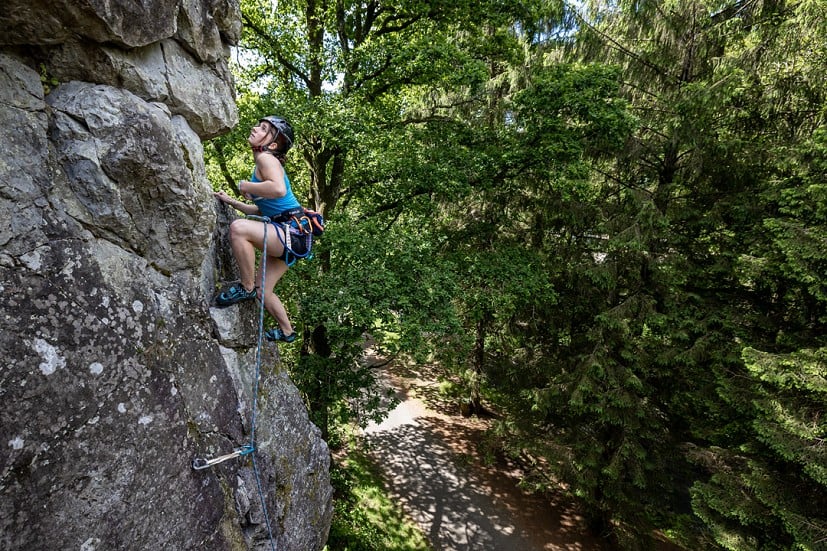
It was however a very active sector in the '70s between the achievements of Abbé Roussel and the piton war! You will still find traces in the slab: Didier Laisné, Jean-Pierre Bouvier and his Mortain companions attacked the bolting of the cliffs... It was thus a little later, in the '80s, under the impulse of Georges Maguet, Christophe Pellé and his friends, with the support of the Normandie-Maine park, (today Geoparc), that standardised bolting was born. Taking advantage of the coolness of the river, you will be able to climb the most continuous overhangs at the roadside: from "La paupière" to "Noces feras-tu" (opened by Jean-Pierre Bouvier and Didier Laisné), passing by "Génération perdue", in any case woe to the defeated: "vae victis" is the most impressive route of the sector. In the evening, before sharing a glass of perry, the local elixir, we finished by lounging on the warm walls of the big bar and doing the great classics, such as "La cabernet", "Objectif nul" or "Dernier Acte".
Today, there are still ten or so routes that are not bolted for trad climbing.
Located on the GR22 linking Paris to the Mont Saint-Michel, the sector abounds in hiking trails (pedestrian, mountain bike...), museums, to discover with family. The local authorities, aware of this jewel, wish to make it discoverable to more people by rehabilitating two lodgings of 4/5 people and a lodging of groups of 26, with a pedestrian route allowing direct access to the Fosse Arthour.
So come and discover King Arthur's playground!
Arnaud Chedeville
Logistics
La Fosse Arthour is near Mortain, around 20 minutes by car. It is perfect to have one or two days at La Fosse Arthour then go to Mortain. The rock is similar.
Guidebook
The guidebook is brand new, the last edition is from 2020. You can buy it online, at the local hostel or the nearest tourism offices.


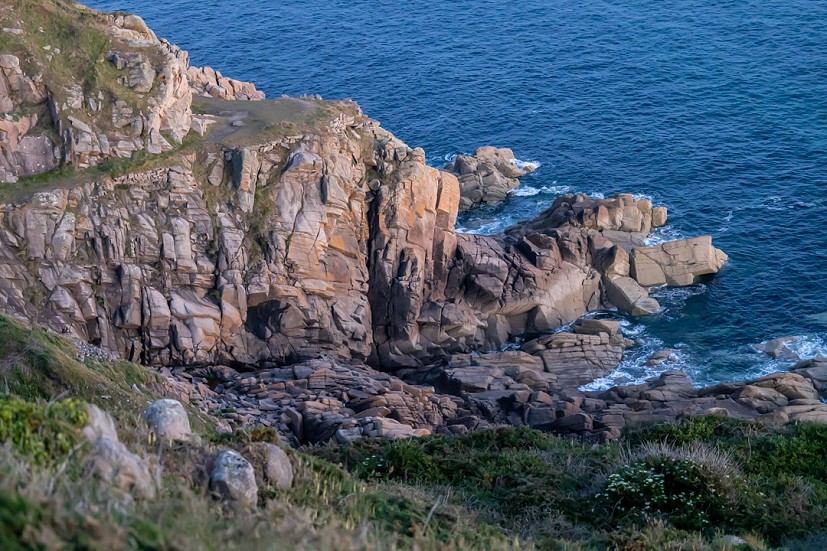
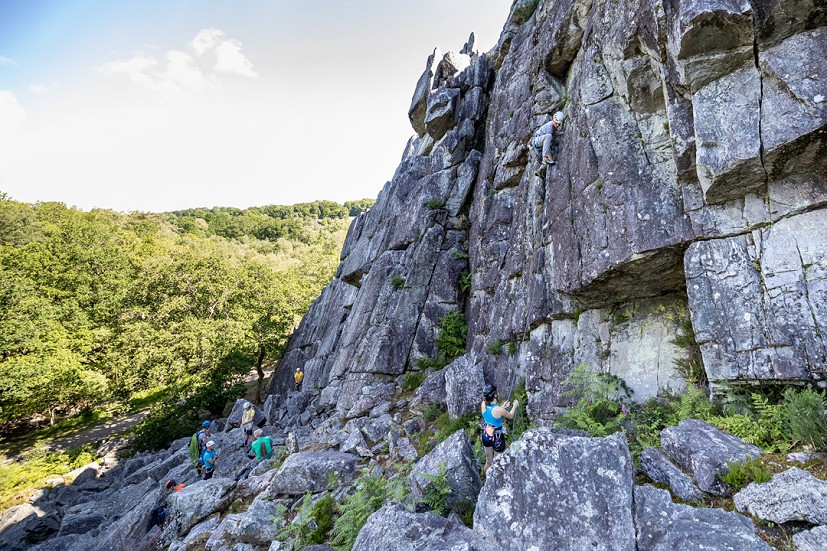


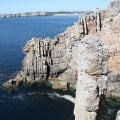

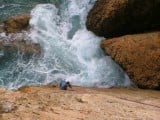

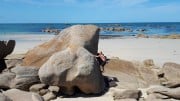


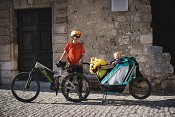
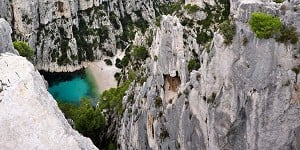


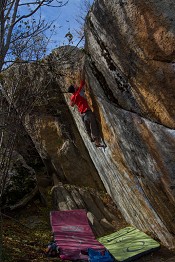



Comments
More destination articles like this please. I'd be interested to know more about more trad climbing venues in the area, even though a couple are mentioned.
I've climbed at Mortain, Clecy & Fosse Arthour. The rock at Mortain and FA is quite cool - I'd describe it as a sandstone metamorphosed to glass - it retains much of the sand texture, but is bullet hard and doesn't turn to sand under your fingers like the rock in RedRocks does. Nice to climb on, and fine in the wet unlike other sandstones. Clecy reminds me of the Dewerstone in it's aspect - you start amongst the trees and pop out into spectacular views. The bolting is somewhat 'sporting' on the 6a and below routes still - plenty of opportunity to hit ledges and the like in places if you come off due to the spacings. Fine if you have a UK trad mentality, but not if you've grown up on grid-bolted modern steep stuff. It's a short walk from the decent campsite to the main sectors. The VF on the other side of the river is good fun and I think can be done for free with your own gear (memory fails me on this). It has a big zipline descent over the river available to those that pay for it. There's also a model train attraction in Clecy but we didn't have time to check it out.
There's not a lot. There's big sea cliffs at Cap De La Hague (you can see them from Guernsey, 30+ miles away), but I suspect the nuclear reprocessing plant above would make those out of bounds. Then it's all sand until Flamanville, then sand until Cap de Carteret. There's potential for a handful of routes and some bouldering there (see the page I created on here). Then I believe it's all sand until the low headlands around St.Malo which may have bouldering or very short routes. Then there's sea cliffs at Cap Frehel. Inland, there's bits and bobs in old quarries at Dol De Bretagne, Dinan, and a couple of other places. The Channel Islands have far more climbing.
That's true, the channels islands have far more Climbing for trad.
For La Hague: you can get informations about nez des voiries here: https://sites.google.com/view/caffmeux/escalade-en-normandie/nez-des-voidries
You can find coastal boulders too: https://sites.google.com/view/caffmeux/escalade-en-normandie/anse-des-moulinets
Great article, some trip ideas there for sure.